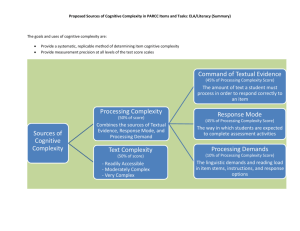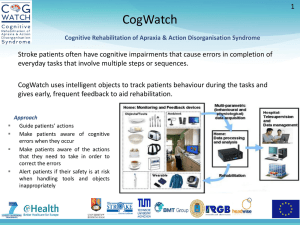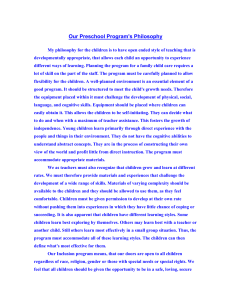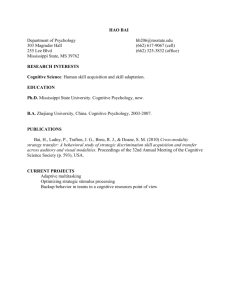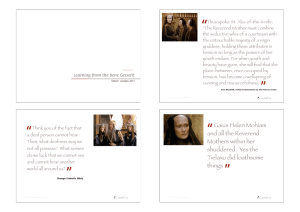TOPIC 2 - THE ROLE OF PSYCHOLOGY IN INFORMATION SYSTEMS
advertisement
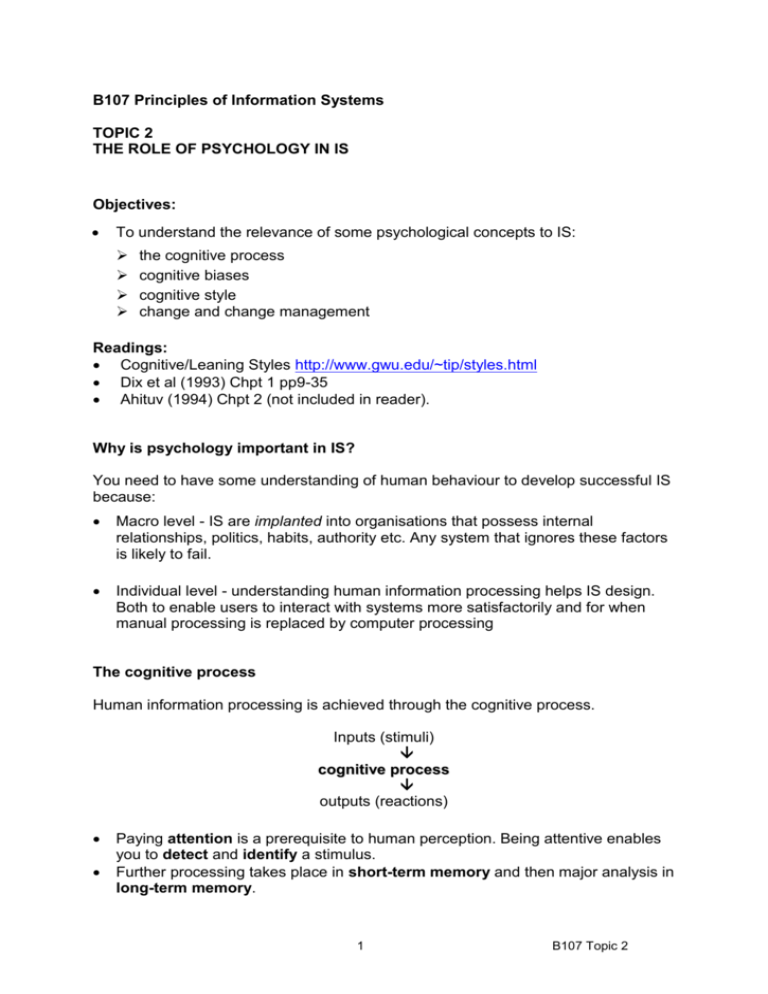
B107 Principles of Information Systems TOPIC 2 THE ROLE OF PSYCHOLOGY IN IS Objectives: To understand the relevance of some psychological concepts to IS: the cognitive process cognitive biases cognitive style change and change management Readings: Cognitive/Leaning Styles http://www.gwu.edu/~tip/styles.html Dix et al (1993) Chpt 1 pp9-35 Ahituv (1994) Chpt 2 (not included in reader). Why is psychology important in IS? You need to have some understanding of human behaviour to develop successful IS because: Macro level - IS are implanted into organisations that possess internal relationships, politics, habits, authority etc. Any system that ignores these factors is likely to fail. Individual level - understanding human information processing helps IS design. Both to enable users to interact with systems more satisfactorily and for when manual processing is replaced by computer processing The cognitive process Human information processing is achieved through the cognitive process. Inputs (stimuli) cognitive process outputs (reactions) Paying attention is a prerequisite to human perception. Being attentive enables you to detect and identify a stimulus. Further processing takes place in short-term memory and then major analysis in long-term memory. 1 B107 Topic 2 Cognitive process attention Sensory Memory Identification Stimulus Short-term Memory Reaction Long-term Memory Sensory memory acts as buffer for stimuli received through the senses (one buffer for each channel). Information only remains in sensory memory for about 0.5 sec. Attention refers to how we actively process a limited amount of information from the enormous amount of information available. It includes both conscious and unconscious processes. perception involves awareness the environment is full of potential signals we actively seek and select those with the faculty of attention but we subconsciously notice and filter much (e.g. cocktail party effect) Identification Identification (or recognition) is the cognitive process that tries to identify the stimulus. There are various theories about how this occurs. Is probably both: Data driven – reflects the structure of the arriving data Conceptually driven – we use preconceptions to interpret the data For example: 1 3 0 Y. Data driven identification would categorise it as the number 130 followed by the letter Y, but if that had no meaning in the context it might be perceived as BOY. Short Term Memory (STM) Transitory (few seconds), for working not storage. Limited capacity (say) 7 + 2 “chunks”. Chunking involves grouping units of information (hierarchical) 2 B107 Topic 2 Examples Write down as much of this sequence as you can remember: 2653976208 Now try: 08 9242 6378 What about? HEC ATR ANU PTH ETR EET Long Term Memory (LTM) Absorbs and stores data Must have been through STM processing Attention and learning are applied Rehearsal (rote) helps retention Meaningfulness helps retention 2 types: memory of events (episodic memory) and memory of concepts (semantic memory) Could it be forever? Biases in the cognitive process We often speed up perceptual data processing by conceptual matching - involving preconceptions. But such biases can lead to errors! Common processing biases: confusion (e.g. F and E on eye charts) ambiguity (the astronomer married the star) information overload (an unbroken, “meaningless” lecture!) filtering – we only filter the signals we preconceive to be relevant 3 B107 Topic 2 Cognitive Styles People differ in how they like to think about and solve problems. Some people are better at verbal thinking, working more effectively with words and numbers. Others are better at spatial reasoning; they prefer to manipulate symbols and pictures. Some people are analytic thinkers who systematically analyse the aspects of a problem. Others are more intuitive and rely on rules of thumb and hunches. These kinds differences are known as differences in cognitive style. Cognitive style is an individual's inherent and consistent way of organising and processing information. Many different dimensions of cognitive style have been identified. These include: Preceptive versus receptive Preceptive people wish to grasp the whole picture and avoid going into details Receptive people are attentive to details Analytic vs intuitive Analytic people look for a method to achieve the best solution Intuitive people don’t commit themselves to a method Field dependent versus field independent Field dependent information processing is passive. Field independent traits include complex and individualistic hypothesis-testing and restructuring skills, used to reason about ambiguous and demanding problems. Users with different cognitive styles can have different preferences with respect to the kinds of information they require from an information system and for the kinds of interface to systems. For example, a verbal, analytical, concrete thinker might prefer a textual style of interface, but a spatial, intuitive, abstract thinker might feel more comfortable with a multimedia graphical interface. Cognitive style and IS Individual level Systems must be flexible enough to satisfy individuals with different cognitive styles E.g. Active versus passive help Levels of reporting detail for statistical info. Optional features for different cognitive styles e.g. verbalisers vs visualisers. 4 B107 Topic 2 Group level There is some evidence that various professions tend to possess certain cognitive style patterns – so this may be useful when designing an IS for a particular group. e.g. auditors are more compatible with the receptive-systematic style. Question Do you think IT professionals have a characteristic cognitive style? Organisational level issues: The psychological climate New IS can disrupt equilibriums between parties in an organisation. An IS may be opposed because of the psychological climate rather than the technical quality of the system. Psychological climates (wrt IS) develop out of continuous interactions between individuals and groups in an organisation. The major parties are: Users Management IT professionals Other important parties include: Customers IT vendors Factors that influence the psychological climate include: Users’ prior experiences with systems Potential impact of the system on individuals’ ‘power’ Realism of management expectations Ability of IT professionals to negotiate the existing psychological climate 5 B107 Topic 2 Introducing new systems Many people resist change: replacement of functions eliminates jobs structural changes rebalance power modifying procedures engender confusion Managing change requires good psychological awareness. Management of Change Model (Lewin): Research indicates that change involves the following stages: Unfreezing: Disturbing the current stable equilibrium and hence introducing the need for change. Movement: Presenting new directions and conducting a learning process until the plans are accepted and new strategies are implemented. Refreezing: Integrating the change with existing behavioural networks so that it becomes integrated into the status quo. Resistance to change reflects an incomplete or unsuccessful refreezing - either participants are not motivated enough or they fear change more than they value probable benefits. The process of facilitating change is called change management Responsibilities of change agents: Unfreezing: gather data, diagnose problems, decide if change is needed, and make others aware of this. This may involve deliberate attempts to raise the group's level of discontent. Movement: Develop a plan, set goals and objectives, Identify areas of support and resistance. Set target dates, and implement the strategies. Be available to support others through the change. Finally, modify (if necessary) and evaluate. Refreezing: Support others so that the change remains in place. Some practical conclusions for IS Understanding psychology is vital for IS development. Psychology is important at both individual and group levels. Important information must attract attention Part of information identification is performed by pattern recognition – presentation must take account of this. Information overload may lead to important information not being absorbed (STM ~ 7 chunks) – but important information should be repeated (rehearsal needed) Develop systems that take advantage of understood formats (spreadsheets etc) Design systems to support a wide range of cognitive styles 6 B107 Topic 2
